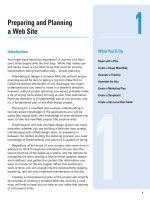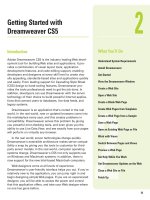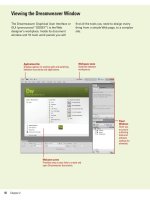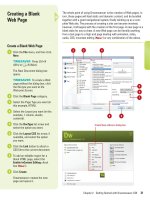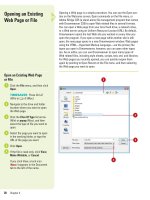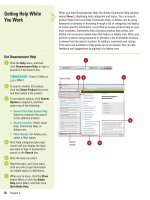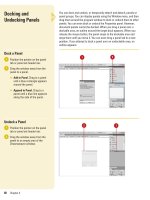adobe dreamweaver cs5 on demand part 59 docx
Bạn đang xem bản rút gọn của tài liệu. Xem và tải ngay bản đầy đủ của tài liệu tại đây (725.79 KB, 6 trang )
ptg
362 Chapter 15
The Go To URL behavior gives you the ability to link an element on a
Web page to an URL address. For example, you can create a Web
page, and then use the Go To URL behavior to direct visitors to other
sites and pages, or you can create a set of interactive buttons for use
on a standard HTML driven Web site. Whichever option you choose,
the ability to direct a visitor to other Web sites is essential to creating
Internet-oriented documents.
Going to Another
Web Page
Use the Go To URL Behavior
Open the Web page you want to
apply a behavior.
Click the Window menu, and then
click Behaviors to display the
Behaviors panel.
Click the element you want to add
the Go To URL behavior.
Click the Add Behavior button
(plus sign), and then click Go To
URL.
A dialog box appears, allowing you
to set the details of the action.
Type the URL or click Browse,
select the URL from the Select File
dialog box, and then click OK.
Click OK.
To cha ng e th e tri gger, clic k th e
event, click the Event list arrow,
and then select the event you
want.
7
6
5
4
3
2
1
1
4
3
2
6
5
7
From the Library of Wow! eBook
ptg
Chapter 15 Working with Behaviors 363
The Open Browser behavior allows you to set a hyperlink to open in a
new browser window. When you use the Open Browser behavior, you
need to specify the URL you want to open in the new browser window
and any window attributes, such as width, height, navigation and loca-
tion toolbar, status bar, menu bar, scrollbar as needed and resize han-
dles. If you want to use this behavior with text, you can also use the
Change Property and Change Property Restore behaviors to change the
pointer to a hand when visitors hover over your text link.
Opening Another
Browser Window
Open Another Browser Window
Open the Web page you want to
apply a behavior.
Click the Window menu, and then
click Behaviors to display the
Behaviors panel.
Click the element you want to add
the Open Browser Window
behavior; typically link text or
graphic.
Click the Add Behavior button
(plus sign), and then click Open
Browser Window.
A dialog box appears, allowing you
to set the details of the action.
Type the URL or click Browse,
select the URL from the Select File
dialog box, and then click OK.
Enter a window size (width and
height in pixels).
Select the check boxes with the
window attributes you want to
use.
Enter a window name. The
window name is used in the
behavior script, so it cannot have
any spaces or special characters.
Click OK.
To cha ng e th e tri gger, clic k th e
event, click the Event list arrow,
and then select the event you
want.
10
9
8
7
6
5
4
3
2
1
1
3
4
2
8
5
9
7
6
10
From the Library of Wow! eBook
ptg
364 Chapter 15
Dreamweaver provides several behaviors to display user text mes-
sages, including Popup Message and Set Text. The Set Text behavior
consists of four individual behaviors: Set Text of Container, Set Text of
Frame, Set Text of Status Bar, and Set Text of Text Field. These behav-
iors allow you to display text in an alert dialog box, a container, specific
frame, text field, or the Status bar.
Displaying Text
Messages
Create a Popup Message
Window
Open the Web page you want to
apply a behavior.
Click the Window menu, and then
click Behaviors to display the
Behaviors panel.
Click the element you want to add
the Popup Message behavior.
Click the Add Behavior button
(plus sign), and then click Popup
Message.
A dialog box appears, allowing you
to set the details of the action.
Type the message you want.
Click OK.
To cha ng e th e tri gger, clic k th e
event, click the Event list arrow,
and then select the event you
want.
7
6
5
4
3
2
1
1
4
2
3
6
5
7
From the Library of Wow! eBook
ptg
Chapter 15 Working with Behaviors 365
Create a Status Bar Message
Open the Web page you want to
apply a behavior.
Click the Window menu, and then
click Behaviors to display the
Behaviors panel.
Click the element you want to add
a behavior.
Click the Add Behavior button
(plus sign), point to Set Text, and
then click Set Text Of Status Bar.
A dialog box appears, allowing you
to set the details of the action.
Type the message you want.
Click OK.
To cha ng e th e tri gger, clic k th e
event, click the Event list arrow,
and then select the event you
want.
7
6
5
4
3
2
1
1
4
3
2
6
5
7
From the Library of Wow! eBook
ptg
366 Chapter 15
The Preload Images behavior allows you to preload images when a
Web page initially loads. This is useful when you want to swap images
on mouse rollover buttons. The Preload Images behavior loads the
rollover image when the page initially loads, so visitors will not experi-
ence a delay while the image loads the first time a visitor points to the
button. The Swap Images behavior allows you to swap one image for
another when an event occurs. The most common use of this behavior
is to create rollover buttons. Along with the Swap Image behavior, you
can also use the Swap Image Restore behavior, which restores the
images that were swapped by the Swap Image behavior.
Preloading and
Swapping Images
Preload Images
Open the Web page you want to
apply a behavior.
Click the Window menu, and then
click Behaviors to display the
Behaviors panel.
Click the element or <body> tag in
the tag selector for the entire page
you want to add the Preload
Images behavior.
Click the Add Behavior button
(plus sign), and then click Preload
Images.
A dialog box appears, allowing you
to set the details of the action.
Click Browse, locate and select
the image you want to preload,
and then click OK.
Click the Add Items button (plus
sign).
To add mo re i ma ge s, repe at s te ps
5 and 6.
Click OK.
To cha ng e th e tri gger, clic k th e
event, click the Event list arrow,
and then select the event you
want.
9
8
7
6
5
4
3
2
1
3
2
4
1
8
5
6
9
From the Library of Wow! eBook
ptg
Chapter 15 Working with Behaviors 367
Swap Images
Open the Web page you want to
apply a behavior.
Click the Window menu, and then
click Behaviors to display the
Behaviors panel.
Click the image you want to swap.
Click the Add Behavior button
(plus sign), and then click Swap
Image.
The selected image appears
highlighted in the Swap Image
dialog box.
Click Browse, locate and select
the image you want to swap it
with, and then click OK.
To ins er t a Pre lo ad Imag es
behavior, select the Preload
Images check box.
To ins er t a Swa p Im ag e Re st or e
behavior, select the Restore
Images onMouseOut check box.
To rem ov e a swa p, s el ec t an
image in the list, and then delete
the file and path in the Set Source
To box .
Click OK.
To cha ng e th e tri gger, clic k th e
event, click the Event list arrow,
and then select the event you
want.
10
9
8
7
6
5
4
3
2
1
3
2
4
1
7
8
6
9
5
10
From the Library of Wow! eBook
